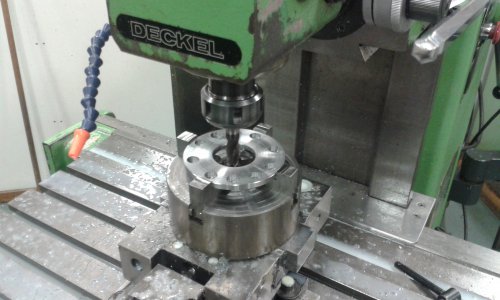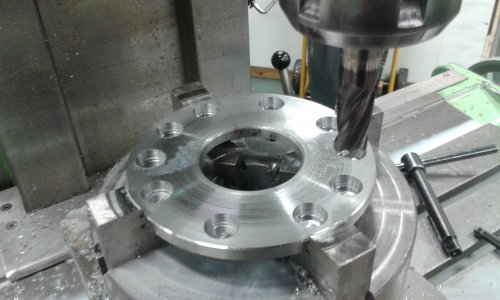- Joined
- Jan 6, 2014
- Messages
- 42
Hi Holt
It was quite a journey to get to work. The student does not have a very big gearbox and I wanted to have a one to one pulley ratio. The other problem was there was not place to put a tensioner in. While looking for pulleys in a friends workshop I can across this strange pulley which was adjustable by turning the side of the pulley in and out. I knew one pulley would not be enough and shopped around but could not buy another one in South Africa. Then another friend found me one at a boot sale. The is quite a bit of space between the pulleys when put next to each other. I solved this my putting a 3 groove pulley on the spindle. The next problem was the part of the gearbox casting where the selectors are was in the way. A small angle grinder and a lot of bad language sorted that out. There also a part of the casting under the gears for lubricating which need to be cut out.
Although it looks like the gearbox has not oil in it, it does have oil in it. On the left you have the gears for the feed. Lucky this area is in a little box which is lower that the main area. So I lubricate the bearing/bushes normal thought there oil nipples and the surplus oil drains off to the feed gears box/sump. Once a month I open the top cover just to check the lever as you don't want the lever to high as the the belts will get oil on them a slip. I am going to drill a hole into the gearbox casing as the level i want and then surplus oil can drain out into a bottle and the be emptied as necessary.
It works very nicely and is very quite. There is one problem, at lower speeds the torque is very low and if drilling with large drill the motor does stop it you not careful. I am going to charge the motor pulley size to see if I can reduce this problem. I did fit a digital rev counter to the back of the spindle which does help to quickly see the speed you running.
A quick change tool post is a must. But you will find that you will need a lot of the tool holders. I am nearly finished making 12 new ones to add to the 6 I already have. The same type are yours.
It was quite a journey to get to work. The student does not have a very big gearbox and I wanted to have a one to one pulley ratio. The other problem was there was not place to put a tensioner in. While looking for pulleys in a friends workshop I can across this strange pulley which was adjustable by turning the side of the pulley in and out. I knew one pulley would not be enough and shopped around but could not buy another one in South Africa. Then another friend found me one at a boot sale. The is quite a bit of space between the pulleys when put next to each other. I solved this my putting a 3 groove pulley on the spindle. The next problem was the part of the gearbox casting where the selectors are was in the way. A small angle grinder and a lot of bad language sorted that out. There also a part of the casting under the gears for lubricating which need to be cut out.
Although it looks like the gearbox has not oil in it, it does have oil in it. On the left you have the gears for the feed. Lucky this area is in a little box which is lower that the main area. So I lubricate the bearing/bushes normal thought there oil nipples and the surplus oil drains off to the feed gears box/sump. Once a month I open the top cover just to check the lever as you don't want the lever to high as the the belts will get oil on them a slip. I am going to drill a hole into the gearbox casing as the level i want and then surplus oil can drain out into a bottle and the be emptied as necessary.
It works very nicely and is very quite. There is one problem, at lower speeds the torque is very low and if drilling with large drill the motor does stop it you not careful. I am going to charge the motor pulley size to see if I can reduce this problem. I did fit a digital rev counter to the back of the spindle which does help to quickly see the speed you running.
A quick change tool post is a must. But you will find that you will need a lot of the tool holders. I am nearly finished making 12 new ones to add to the 6 I already have. The same type are yours.



